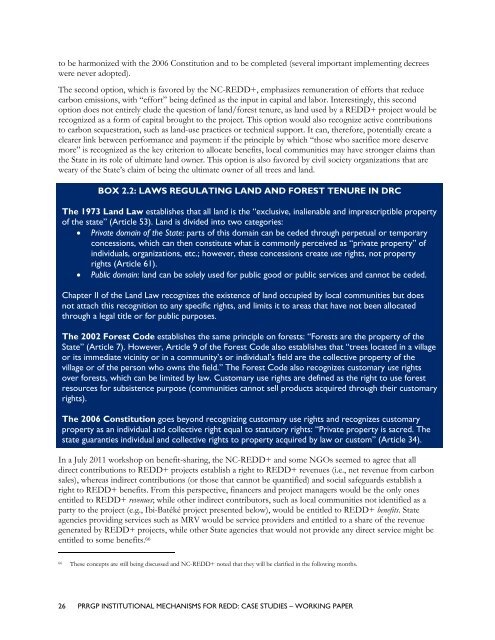Institutional Mechanisms for REDD+ - Case Studies Working Paper
Institutional Mechanisms for REDD+ - Case Studies Working Paper
Institutional Mechanisms for REDD+ - Case Studies Working Paper
Create successful ePaper yourself
Turn your PDF publications into a flip-book with our unique Google optimized e-Paper software.
to be harmonized with the 2006 Constitution and to be completed (several important implementing decrees<br />
were never adopted).<br />
The second option, which is favored by the NC-<strong>REDD+</strong>, emphasizes remuneration of ef<strong>for</strong>ts that reduce<br />
carbon emissions, with ―ef<strong>for</strong>t‖ being defined as the input in capital and labor. Interestingly, this second<br />
option does not entirely elude the question of land/<strong>for</strong>est tenure, as land used by a <strong>REDD+</strong> project would be<br />
recognized as a <strong>for</strong>m of capital brought to the project. This option would also recognize active contributions<br />
to carbon sequestration, such as land-use practices or technical support. It can, there<strong>for</strong>e, potentially create a<br />
clearer link between per<strong>for</strong>mance and payment: if the principle by which ―those who sacrifice more deserve<br />
more‖ is recognized as the key criterion to allocate benefits, local communities may have stronger claims than<br />
the State in its role of ultimate land owner. This option is also favored by civil society organizations that are<br />
weary of the State‘s claim of being the ultimate owner of all trees and land.<br />
BOX 2.2: LAWS REGULATING LAND AND FOREST TENURE IN DRC<br />
The 1973 Land Law establishes that all land is the “exclusive, inalienable and imprescriptible property<br />
of the state” (Article 53). Land is divided into two categories:<br />
� Private domain of the State: parts of this domain can be ceded through perpetual or temporary<br />
concessions, which can then constitute what is commonly perceived as “private property” of<br />
individuals, organizations, etc.; however, these concessions create use rights, not property<br />
rights (Article 61).<br />
� Public domain: land can be solely used <strong>for</strong> public good or public services and cannot be ceded.<br />
Chapter II of the Land Law recognizes the existence of land occupied by local communities but does<br />
not attach this recognition to any specific rights, and limits it to areas that have not been allocated<br />
through a legal title or <strong>for</strong> public purposes.<br />
The 2002 Forest Code establishes the same principle on <strong>for</strong>ests: “Forests are the property of the<br />
State” (Article 7). However, Article 9 of the Forest Code also establishes that “trees located in a village<br />
or its immediate vicinity or in a community’s or individual’s field are the collective property of the<br />
village or of the person who owns the field.” The Forest Code also recognizes customary use rights<br />
over <strong>for</strong>ests, which can be limited by law. Customary use rights are defined as the right to use <strong>for</strong>est<br />
resources <strong>for</strong> subsistence purpose (communities cannot sell products acquired through their customary<br />
rights).<br />
The 2006 Constitution goes beyond recognizing customary use rights and recognizes customary<br />
property as an individual and collective right equal to statutory rights: “Private property is sacred. The<br />
state guaranties individual and collective rights to property acquired by law or custom” (Article 34).<br />
In a July 2011 workshop on benefit-sharing, the NC-<strong>REDD+</strong> and some NGOs seemed to agree that all<br />
direct contributions to <strong>REDD+</strong> projects establish a right to <strong>REDD+</strong> revenues (i.e., net revenue from carbon<br />
sales), whereas indirect contributions (or those that cannot be quantified) and social safeguards establish a<br />
right to <strong>REDD+</strong> benefits. From this perspective, financers and project managers would be the only ones<br />
entitled to <strong>REDD+</strong> revenues; while other indirect contributors, such as local communities not identified as a<br />
party to the project (e.g., Ibi-Batéké project presented below), would be entitled to <strong>REDD+</strong> benefits. State<br />
agencies providing services such as MRV would be service providers and entitled to a share of the revenue<br />
generated by <strong>REDD+</strong> projects, while other State agencies that would not provide any direct service might be<br />
entitled to some benefits. 66<br />
66 These concepts are still being discussed and NC-<strong>REDD+</strong> noted that they will be clarified in the following months.<br />
26 PRRGP INSTITUTIONAL MECHANISMS FOR REDD: CASE STUDIES – WORKING PAPER

















